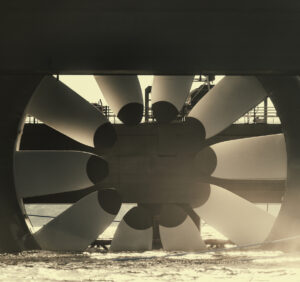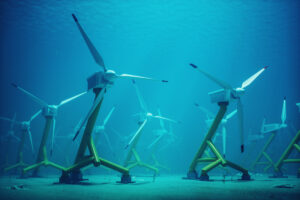Riverine Turbines: A Wonderful New Old Idea
Wind and solar are good options for ending our long addiction to fossil fuels, and we must continue developing them as quickly as possible—even though the wind doesn’t always blow and the sun doesn’t shine at night. But we also need to focus new attention on an old, very dependable source of cheap electric power that has been right before our eyes all along. We are slow to recognize its enormous potential.
That source is our rivers. America is a land of beautiful rivers, mighty rivers, that forever flow. And unlike the wind and the sun, their flow never stops. A river’s constant powerful flow is easily turned into cheap, dependable, abundant electricity. Best of all, it can be done without huge dams backing up huge lakes so that water can fall through huge vertically-mounted generators inside the dam. Though that obsolete model served us well, we now understood the harm done to our riverside ecologies, habitats and wetlands by those thousands of dams all over the USA. We’re beginning the long task of removing them because we don’t need dams to generate electricity anymore, we’re beyond that. The very fact that rivers never stop flowing can be used to generate far more electric power than we’ve ever dreamed of.
We begin by initiating pilot projects across the nation to determine best ways to use water turbines for generating electricity. Among several types of water turbines, the horizontal tube is my favorite. A riverine tube turbine is simply a small water-tight generator—smaller than a car—turned on its side and secured horizontally inside a large protective metal tube that can be submerged just below the river’s surface.
The river’s current flows continuously through the tube, turning a large propeller which spins the turbine to generate a constant flow of electricity. Multiple such tubes can be hooked together in series, one behind the other. The series is then secured to the riverbank by long metal arms that are hinged to allow the tube turbines to rise and fall with the water’s level in every stage from low water to flood. Thus hitched in series, a few dozen of these tubes can generate enough electricity to supply hundreds of homes and farm operations. By multiplying them along unused river banks, these simple, cheap generators can replace whole power plants—and take over the job of providing electric power for America’s towns and cities.
After initial construction, the only cost is maintenance. Large debris such as floating trees can be turned aside by a curved deflector at the upstream end of each series. Small waterborne debris flows through the turbine—as do fish, unharmed—and the turbine keeps right on turning, generating extremely low-cost power all across the United States. There is no coal or natural gas to buy, ever. There is no coal ash or nuclear waste to be somehow got rid of, ever. There isn’t even a costly heat exchanger like those few power plants that tap the earth’s geothermal heat. Best of all, there’s no carbon dioxide involved at all. Ever. There is only the flowing water—and our nation’s old rivers just keep on rolling along, year after year—even when the sun don’t shine and the wind don’t blow.
Our nation has tens of thousands of miles of rivers—and every river has two banks. Around ninety percent of those banks are now wasted space, unused for any purpose. But a great many of them are ideal for placement of tube turbines to generate plentiful, dependable, and cheap electricity for nearby homes, farms, towns and cities. Decentralizing electricity generation in this way will also enable decentralizing our nation’s power grid. By generating electric power close to where we use it, we reduce the need for costly, unsightly, high power lines across our landscape. Moreover, as existing fossil fuel power plants are retired, we won’t need to replace them with anything—we won’t need them anymore.
Consider the sheer amount of electricity we can generate throughout the American heartland alone, by putting to good use all those hundreds of miles along the banks of the Ohio, the Missouri and Mississippi rivers—not to mention the Wabash, the Tennessee, the Cumberland, the Kanawha—and so many more. What large ever-flowing river is nearest your home? Installing tube turbines along unused sections of the banks of our nation’s many rivers, with their year-round steady flow, has potential to provide far more electricity than we are likely to need in this century. Pilot projects will refine the numbers on how many tube turbines are necessary to supply rural areas, towns and cities of various sizes.
In modern dollars this nationwide project—call it the River Energy Initiative—will be a lot cheaper and far less difficult, not to mention quicker—than was creating the Eisenhower Interstate Highway System. But it will be at least equal to the interstates in its beneficial impact for the nation. It should be highest priority among hundreds of major new projects to properly, finally, update our nation’s aging infrastructure—including our interstate highway system.
The River Energy Initiative will create many millions of new good paying jobs all across the USA. And those new jobs will enable millions of struggling American families to lift themselves back up into secure middle class living where they should have been all along. Many of the riverside rights of ways where these tube turbines are installed can be turned into public parklands—natural areas suitable for hiking, biking, fishing and recreation, with scenic roads to facilitate turbine maintenance and tourism.
To get on with it, we need Congressional legislation creating a U.S. River Power Administration—a new federal agency responsible to install tube turbines along our national waterways, and maintain them forevermore. This agency must have authority to contract—at guaranteed living wages—with private companies for construction and maintenance of the turbines, and the bidding rules must contain attractive incentives for new, small and local entrepreneurs to get involved.
Finally, this new electricity source—quick and easy to build, cheap to maintain, operating with none of the social costs of power plants—can usher in a new era in the home economics of living in the USA. Electricity from the River Energy Initiative should be available at no charge for the normal residential needs of every home—rural and urban—that has household income below the federally defined poverty level. Regardless whether a home is owned or rented, residential households should pay an electricity bill only when their aggregate household income is above the poverty level. Where there is a bill to pay, the bill should be reverse-graduated so that the less electricity you use, the less you pay per unit of electricity used. Any household using more than an adequate share of electricity should pay disproportionately more for its excessive demand.
Summing up, these measures would in a single stroke 1) make our electricity cheaper and more dependable by decentralizing the nation’s entire generating system; 2) facilitate modernized distribution by upgrading to one unified smart grid nationwide, 3) create a vast pool of new jobs to build the system and maintain it; 4) establish an important component of economic rights for low income Americans; and 5) provide incentives against excessive and unreasonable consumption of electric power.
Finally, I must mention how enormously this environmentally-friendly River Energy Initiative would help remove carbon pollution from our atmosphere—here at home and around the world. It certainly would be the greenest project in American history.

